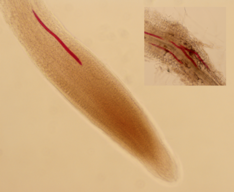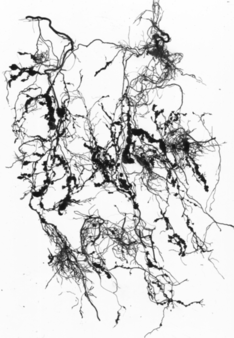Development of Root-knot Nematodes Reproduction Models
One of the key factors affecting the reproduction of root-knot nematodes (RKN) is temperature. The model, which was developed at the Agricultural Institute of Slovenia, allows predictions to be made about the time it takes RKN species to develop a single generation at a given temperature, or it can determine the number of generations that RKN species can develop in one growing season. The model can be useful in assessing the host status of plants (whether a particular plant species is a good or bad host for nematodes), in vegetable and crop production in greenhouses or in the field. The model also enables predictions to be made by taking into account the effects of climate change.

Meloidogyne spp. larvae in the root of the host plant
The influence of plant-parasitic nematodes on plant physiology
Root-knot nematodes are obligate endoparasites (parasites that cannot survive without a host) that feed on the root tissue of host plants and cause direct damage to the plants. In the roots, they cause the formation of multinucleated cells that serve as feeding sites. We have investigated the relationship between the morphological changes in the roots and physiological processes in the plant, both affected by root-knot nematodes. The morphological changes in the roots as well as the surface area and length of the roots were assessed by recording the root system and then analysed using the WinRHIZO software. We analysed the hydraulic conductivity of the roots, the water potential of the leaves, net photosynthesis, stomatal conductance, transpiration and the xanthophyll cycle.
Roots infested by root-knot nematodes
